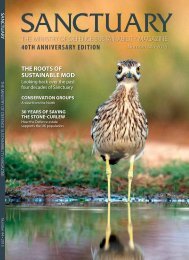SUSTAINABILITY
UBUt5
UBUt5
Create successful ePaper yourself
Turn your PDF publications into a flip-book with our unique Google optimized e-Paper software.
FEATURES<br />
Preservation strategies include the<br />
identification of heritage assets on<br />
military maps, the erection of ‘no-dig’<br />
signs (the instantly recognisable star<br />
signs) and cyclical condition<br />
monitoring visits. The exclusion of<br />
fragile archaeological sites from<br />
military training is featured in standing<br />
orders for ranges and training areas,<br />
and briefings to military users<br />
specifically mention the location and<br />
fragility of heritage. Routine<br />
management tasks such as bracken<br />
control on earthwork monuments are<br />
identified within site Integrated Rural<br />
Management Plans. Other issues are<br />
quickly identified and business cases<br />
for conservation works are developed<br />
to secure funding and clearances. This<br />
overall approach has been highly<br />
beneficial for Welsh heritage.<br />
Roman coin – Caerwent © Crown<br />
These traditional archaeological sites<br />
are not necessarily restricted to the<br />
larger, more rural ranges; the enigmatic<br />
Roman building at Whitewall Brake in<br />
Caerwent Training Area is curiously<br />
co-located within the densely built up<br />
network of industrial buildings that<br />
comprised the former Royal Naval<br />
Propellant Factory. Even during WWII<br />
the value of heritage was identified<br />
and protected, perhaps a sense<br />
sharpened through fear of what might<br />
be lost in the near future. A MOD<br />
excavation by Operation Nightingale is<br />
defining the character of this<br />
monument in a measured manner,<br />
respectful of the monument’s<br />
scheduled status.<br />
structures and the carefully<br />
constructed and managed use of<br />
space, for example impact and<br />
danger areas.<br />
Locating military training – with its<br />
emphasis on digging-in, the use of<br />
heavy machinery and impacts from<br />
munitions – in areas of high<br />
archaeological sensitivity may seem<br />
counter-productive and destined for<br />
catastrophic failure. While rare<br />
accidents and misunderstandings<br />
inevitably happen, in general the<br />
robust, proactive and careful<br />
management of military activities in<br />
Wales has ensured that historic<br />
environment assets are successfully<br />
protected from unnecessary<br />
destruction and ill-considered change.<br />
Central to this success was the<br />
establishment of the conservation<br />
groups during the 1970s. A number<br />
thrive in Wales with active<br />
memberships and work programmes.<br />
Such fora are incredibly useful<br />
opportunities for informed and<br />
respectful dialogue between the MOD,<br />
Statutory Bodies and other interested<br />
parties. Proposals can be discussed,<br />
issues raised, evidence identified and<br />
cognisant decisions made.<br />
The future holds many challenges for<br />
the Defence estate. Defence needs<br />
continue to evolve with the Defence<br />
requirements of the national interest<br />
and there is greater pressure to work<br />
within a physically smaller footprint.<br />
The ongoing disposal programme and<br />
the requirements to upgrade existing<br />
and create new facilities means that<br />
heritage concerns need to be an early<br />
and central consideration and that<br />
appropriate actions (always<br />
comprehensive archaeological<br />
recording, and sometimes designation)<br />
are put in place.<br />
The historic environment assets on the<br />
Defence estate, whether of national,<br />
regional or local importance, must<br />
continue to be proactively managed.<br />
However, change and decay are<br />
inevitable and preservation of<br />
everything is impossible. The aim<br />
should not be to preserve everything<br />
in aspic, but rather to ensure that<br />
change is managed in a sustainable<br />
way. The historic environment is an<br />
asset and not a barrier to change; this<br />
rich cultural inheritance is a vehicle for<br />
regeneration, sustainable<br />
development and for fostering local<br />
militar y character and distinctiveness.<br />
The MOD, as a significant landowner,<br />
manager and curator of important<br />
historic places, has a key role to play in<br />
continuing to ensure that the impact<br />
of change on heritage values is<br />
recognised and managed responsibly.<br />
Informed and appropriate decision<br />
making will continue to ensure that<br />
the heritage values of the historic<br />
environment in Wales are carried<br />
forward for future generations, military<br />
and civilian, to enjoy.<br />
Jonathan Berry<br />
Senior Inspector of Ancient Monuments<br />
and Archaeology<br />
Cadw, Welsh Government<br />
While routine civilian development<br />
and improvement activities may have<br />
been arrested on the Defence estate,<br />
military activities have imposed their<br />
own rich and varied archaeological<br />
evidence in the form of buildings,<br />
WWI trenches – Penally Training Area ATE Pembroke © Wessex Archaeology<br />
Sanctuary 44 • 2015<br />
35



